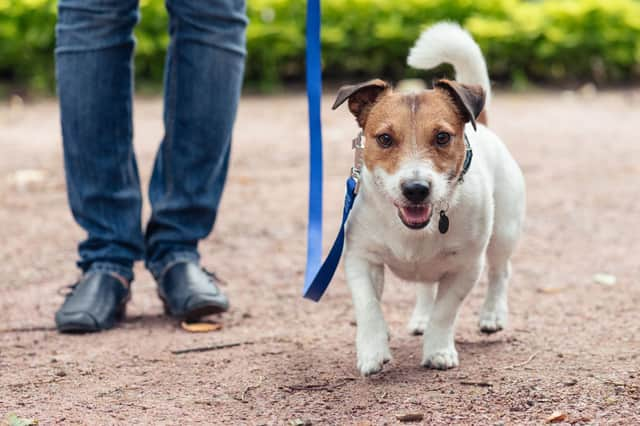Dog Lead Training: Here are 5 expert tips on how to get your adorable dog to walk to heel on a lead


Crucial for keeping the dogs or all breeds and ages (and owners) fit, healthy and active, your daily walks create great bonding time.
Walks facilitate your dog’s mental development and socialisation by allowing them to experience unfamiliar surroundings and people and animals.
Advertisement
Hide AdAdvertisement
Hide AdOf course, for this, they need to be lead trained. You just need three things: a lead, a well-fitted collar (or harness) and plenty of tasty treats.
A nicely-fitted collar will allow you to slip a couple of fingers between it and your puppy. The lead should be of a decent length, able to attach properly to the collar or harness. Treats will allow you to give your pooch plenty of reward for the fantastic progress it is bound to make!
To help you out, the natural dog feed experts at Harringtons, have offered their five top tips.
Get them used to wearing a collar
Where to start with lead training? The answer: the collar. To your puppy, a collar represents a completely unfamiliar object. Having it fastened round their neck, therefore, requires a bit of getting used to.
Introducing a collar to as soon as possible is a great idea. It might be helpful to start with one that’s lightweight, so they barely notice it. Make sure it’s properly fitted using the two fingers trick we mentioned earlier.
The key is to gradually increase the time your puppy is wearing the collar for. It might just be a few minutes at first, but slowly build it up until they’re absolutely at ease. If your pup is trying to wriggle out or get rid of it, quickly distract them with some treats and belly rubs.
Introduce the lead and keep it fun
Once they’re used to the sensation of wearing a collar, the lead comes next. If you’ve got a garden big enough, it’s worth doing a few trial runs to get your young pooch used to walking calmly with you.
You might feel a bit silly, but your puppy won’t. Keep the lead slack, and after a few minutes, stop for a few treats and ball games. This way, they associate the lead with fun and play time. Then, re-attach the lead and do a bit more strolling around!
Gradual socialisation as you hit the great outdoors
Advertisement
Hide AdAdvertisement
Hide AdOnce the lead has become a familiar sight, it’s time to slowly venture outside. Plan a short route where you’re ideally unlikely to encounter any other people. Take things nice and slow — there’ll be sights, sounds and smells that are completely unfamiliar!
It’s possible that your puppy could be overwhelmed, so, like with the introduction of the lead, build it up and keep the encouragement flowing freely.
Harness the power of the treat
Whether you’re rewarding them for being calm and composed when encountering other dogs, or you’re just getting your pup to associate the lead with excitement and joy, treats are a key tool in your arsenal. Use them strategically to reward the best of behaviour!
Teach your puppy to heel
Of course, this is easier said than done — but it’s a crucial final step in your puppy’s lead training.
Many young dogs can be over-excited, so pull on the lead. A puppy which needs constant restraint isn’t technically under control, so teaching them to be ‘at heel’ — walking beside you — is very useful, but often requires patience and practice.
If your puppy seems determined to pull on the lead and charge ahead, it’s worth stopping still. This teaches them that they’re not gaining anything by doing so. If they’re lagging behind, give them plenty of excited, animated encouragement.
One helpful training technique is to ‘stop, start’ with the use of treats and verbal praise for rewards. If they’re surging ahead, get them to calm down and sit down next to you, rewarding them after doing so. Once you start walking again, encourage them to slowly do so as well. Over time, associate a calm, composed walk alongside you with the phrase ‘heel’.
Lead training is a fun, challenging but rewarding journey for owner and canine. With the right encouragement and gradual training, even the most stubborn or excitable dogs can be brought to heel.
Comments
Want to join the conversation? Please or to comment on this article.